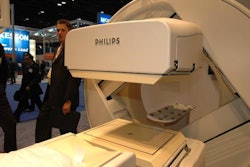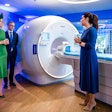CHICAGO - Siemens Medical Solutions of Malvern, PA, is shining the RSNA spotlight on new ultrasound scanners being introduced at the Chicago meeting, as well as enhancements and upgrades for its CT and MRI scanners. The company is also touting new products in its women's health division, such as a new breast biopsy table and a corporate alliance for CR mammography.
Ultrasound
In the ultrasound section of its booth, Siemens is giving RSNA attendees a look at the first two scanners in its X-class family, Acuson X300 and Acuson X500. The systems have been designed to focus on ergonomics, with the X300 being a shared-services system and the X500 is a multispecialty unit. X300 is currently shipping, while X500 is scheduled to be available at the end of the fourth quarter.
Siemens is also highlighting Acuson P10, a new compact ultrasound scanner being shown as a work-in-progress. The company claims the system sets a new standard for compact ultrasound -- the unit is small enough to be carried in a pants pocket.
P10 features an iPod-style interface with button controls designed to be simple and easy to use, according to the company. The vendor is targeting the system at being a screening and triage tool that can enhance physical exams, the company said. The system will be entering clinical trials in the next month, and Siemens did not have an estimate for when P10 would be on the market.
For the company's Acuson Antares system, Siemens is launching a new premium edition that includes breast imaging capabilities based on elasticity imaging. The technique examines the stiffness of breast tissue as a means of detecting potential cancer, given the different tissue strain properties between healthy tissue and tumors. A clinical presentation at the RSNA show by Dr. Richard Barr of Northeastern Ohio Universities College of Medicine in Rootstown indicated that the technique had high specificity in detecting breast lesions.
Other components of the premium edition upgrade include Advanced SieClear spatial compounding, which offers improved detail and contrast resolution, and Dynamic TCE (tissue contrast enhancement), which reduces speckle in B-mode ultrasound images. The company has also added new volumetric and automation capabilities with syngo Auto OB measurements and Advanced fourSight for 3D/4D image acquisition.
For the company's Acuson Sequoia scanner, the firm is highlighting a new high-performance image package that includes a 17L5 HD probe for ultrahigh-frequency scanning from 17-5 MHz. The company is also showing probes with new shapes designed to be easier to grip for technologists.
Other enhancements for the Sequoia and Antares scanners include a syngo fourSight View Tool that supports volume mapping and offline analysis, as well as DICOM multiframes objects.
MRI
Siemens is introducing the next generation of its Tim (Total imaging matrix) technology to advance clinical applications and workflow capabilities.
Tim technology is designed to eliminate the need for patient repositioning and manual coil changes during scans, while enhancing image quality and providing a foundation for new applications.
One technology advancement powered by Tim is syngo TimCT, which offers Continuous Table Move for scanning comparable to CT. It currently is available with Siemens T-class systems for the Magnetom Trio, Magnetom Avanto, and Magnetom Espree. Physicians can acquire one complete planning scan, or peripheral angiography, in a single, continuous move. The table is not required to stay in a fixed position to acquire images.
Siemens' new T-class generation of Tim MRI systems enables shorter order-to-report turnaround time and supports seamless workflow throughout the radiology process, streamlining ordering, planning, processing, and distribution. In addition, Tim Workflow Suite offers efficient planning and automatic real-time composing, filtering, and processing.
T-class also features the new syngo Chorus MR, which integrates the MRI scanner into a RIS and PACS, and provides planning and standardization of protocols across multiple scanners directly from the RIS.
Other Siemens' features on display at RSNA include:
- syngo Twist, which enables 4D MR angiography (MRA), obtaining arterial and venous phases in one scan and providing bilateral MRA, even in cases of a severe stenosis
- syngo Blade for imaging neurological, orthopedic, and abdominal procedures, correcting for motion artifacts in all body regions, even in cases of severe movement
- syngo Grace, which offers breast single voxel spectroscopy, offering user-defined water or lipid signal suppression
- syngo DTI Tractography, which allows 3D visualization of white-matter tracts in the brain for improved neurosurgical planning, based on diffusion tensor imaging (DTI) up to 256 directions
Women's health
Siemens is launching the newly acquired MammoTest prone table, which expands the company's biopsy portfolio of upright or prone stereotactic systems.
Siemens purchased the rights to the MammoTest system this past summer from the former Fischer Imaging of Denver. The technology features 360˚ lesion access and an ergonomically designed table for improved patient comfort. Siemens plans to begin selling the unit globally by the end of this year and will incorporate its syngo platform in 2007.
Siemens also is promoting Fujifilm Medical Systems USA's FCRm system as part of its exclusive agreement to sell the Stamford, CT-based company's full-field digital mammography (FFDM) system. Fuji's FFDM system is the first and only computed radiography (CR) system for mammography that has been cleared by the U.S. Food and Drug Administration (FDA).
The technology has two configurations: a single- or multiplate cassette reader, both providing 18 x 24-cm and 24 x 30-cm fields-of-view, 50-micron pixel sampling, and Fuji's patented dual-side reading technology. The ClearView-1m single-plate reader can be installed in the exam room to address high volume screening and the ClearView-CSm multiplate reader can accommodate exam volume of up to three screening rooms with a throughput of up to 20 breast screening exams per hour.
CT
In the CT section of its booth, Siemens is touting sales of its dual-source Somatom Definition scanner, first introduced at the 2005 RSNA show. The company has installed 100 Definition scanners, with 150 expected to be installed by the end of 2006. Definition users have scanned some 15,000 cardiac patients without beta-blockers since the system began shipping, according to the company.
Dual-energy imaging with Definition -- in which the two x-ray sources operate at two different kV energy levels in simultaneous spiral scanning -- is a particular highlight at this year's meeting, especially since Siemens got FDA clearance for six dual-energy applications in October.
The company believes that the technique is particularly useful for automated bone removal in anatomical locations where bone removal previously was a cumbersome task. Dual-energy imaging also has application in brain perfusion studies, and the company is even seeing interest in the technology in musculoskeletal imaging, for separating tendon and ligament from bone.
For the firm's older Somatom Sensation system, Siemens is discussing a Web Selection concept that provides access to 3D CT volume data at any Internet-connected computer in the healthcare enterprise.
Siemens is also talking up the recent FDA approval of its premarket approval (PMA) application for syngo Lung CAD, designed for computer-aided detection of solid lung nodules in chest CT studies.
X-ray
Among the new product introductions in the x-ray section of Siemens' booth is Axiom Luminos dRF, a new remote fluoroscopy system with a flat-panel digital detector. The system has been optimized for fluoroscopy imaging of obese patients, with a focus on speeding up workflow of bariatric procedures. The system is awaiting FDA clearance and is being shown as a work-in-progress.
Another highlight is Axiom Artis dBA Twin, a biplane angiography system that features two large 30 x 40-cm flat-panel digital detectors. The system is designed for universal angiography and neuroradiology applications, and also supports the company's optional syngo DynaCT cross-sectional imaging capability.
Axiom Aristos VX Plus is a new version of the company's Axiom Aristos VX entry-level radiography system that features a distance holder that moves the system's detector farther from the stand. The design makes the system more flexible in positioning, and began shipping four to five weeks ago, according to the company.
Axiom Aristos FX Plus is another enhancement, this time to the Axiom Aristos FX ceiling-mounted radiography/fluoroscopy (R/F) system. The Plus version eliminates the headpiece on the system's patient table, enabling it to fit into smaller rooms, according to the company. Siemens has also updated the system's software.
In mobile imaging, Siemens has added CR capability to its Mobilett XP line. Mobilett XP CR enables users to conduct bedside imaging, while an integrated monitor provides image review and archiving at the point of care. The company believes that CR can provide benefits not possible with digital radiography (DR), such as using different imaging formats with different imaging cassettes. The system has an integrated CR reader with a reading capacity of 60 imaging plates per hour, and can serve as a centralized single-plate CR reader for multiple rooms.
For the Axiom Luminos TF digital fluoroscopy system, Siemens is discussing a portable DR detector that is integrated into the system's table, enabling the unit to conduct both R/F and radiography studies. The panel can also be removed for additional imaging flexibility.
Molecular imaging
In molecular imaging, Siemens is promoting a number of technologies first introduced at the SNM meeting earlier in the year, and is also introducing a new line of molecular image management and visualization software.
Biograph TruePoint is a version of the company's Biograph 64 PET/CT system that features an extended field-of-view that's 33% larger and collects 78% more photons than the previous Biograph system. The scanner can visualize lesions as small as 3 mm, according to the company.
Another highlight for the Symbia SPECT/CT system is an automated collimator changer first showed at the SNM conference.
On the software side, Clinical Engines is a new concept in software packaging in which the company has bundled its applications in cardiology, neurology, and oncology into distinct packages. Each package is available in three versions, from basic to advanced to premium, and includes standard visualization tools such as Emory Cardiac PET Toolbox for nuclear cardiology imaging.
Multiple applications can be launched from within a single user interface, offering workflow advantages to users, according to the company.
On the preclinical imaging side, Siemens is highlighting a version of its Inveon scanner that includes a PET camera that can be docked with the main system. The company believes the configuration offers increased flexibility for imaging studies conducted separately or in parallel. The company is also discussing its Inveon Research Workplace, which offers postprocessing and analytic capabilities for preclinical imaging.
By Brian Casey and Wayne Forrest
AuntMinnie.com staff writers
November 28, 2006
Copyright © 2006 AuntMinnie.com



















